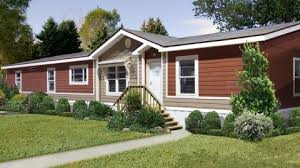The Ultimate Guide to Mobile Home Doors
Replacing a door might seem like a daunting task, especially if you’re a mobile homeowner new to the DIY scene. However, a door is much more than a mere entry and exit point. It’s a significant component of your home, affecting everything from security to energy efficiency and aesthetics. As with any purchase for your mobile home, gaining a better understanding of what you are buying and how to install your new purchase will help tremendously. Measuring correctly, buying the corresponding size, and installing a mobile home door you like are the steps to success! This comprehensive guide will simplify the process of replacing mobile home doors, helping you make the most informed decision possible. Let’s dive in!
Benefits of New Mobile Home Doors
Investing in a new mobile home door is one of the smartest and most affordable home improvement projects you can do. With a multitude of designs and materials available, a door can act as a focal point, reflecting your personal style and enhancing your home’s curb appeal. In fact, according to Zillow, new doors have a return on investment of between 85-100%.
However, a new mobile home exterior door isn’t just about aesthetics; it’s also about function. Doors and windows leak conditioned or warmed air, which can cost a lot to replace. While you can always caulk an old door, replacing a door with higher energy efficiency and safety is best. New doors often come with better insulation, reducing drafts and ensuring your home stays warm in winter and cool in summer. This translates into lower energy consumption, shrinking your utility bills over time. It’s a win-win.
Buying Mobile Home Exterior Doors
But before rushing out to buy a new door, it’s crucial to understand your options. From swing direction, materials, and design, there are many options to consider.
However, as with any building element, there are a lot of parts to a door. Therefore, before shopping, it is essential to know where each of these elements is. To make life a little easier, here is a handy image that shows each of the elements of your mobile home’s front door and their location:

In-Swing, Out-Swing, Left-Hand, Right-Hand
When choosing your mobile home door, one of the first decisions you’ll need to make is whether you prefer an in-swing or out-swing door. The terms ‘in-swing’ and ‘out-swing’ refer to where the door swings when it opens. In-swing doors open into the interior of your home, while out-swing doors open towards the exterior. While each has its benefits, in-swing doors offer more security, while out-swing doors maximize interior space. This decision often boils down to space considerations and personal preference.
However, when we talk about ‘left-hand’ or ‘right-hand’ doors, we mean the door’s hinge position when looking at it from the outside. So a right-hand door has the hinges on the right, and a left-hand door has the hinges on the left.
Which Material is Best for Mobile Home Doors?
Materials matter when it comes to doors. However, the choice largely depends on your budget, maintenance, durability, and aesthetic preferences. There are four common materials for mobile home doors: wood, steel, fiberglass, and aluminum. Here’s a brief overview of each:
Wood Mobile Home Doors
Wood doors are classic and aesthetically pleasing, but there may be better choices for a mobile home. They tend to be more expensive, require more maintenance, and can warp or rot over time due to exposure to moisture. If your mobile home is wet or humid, there might be better choices than wood.
Steel Mobile Home Doors
Steel doors are highly durable and offer excellent security. They’re also relatively affordable compared to wood. They are resistant to warping and rotting, requiring less maintenance than wooden doors. However, they provide less insulation than wooden doors and can be prone to dents and rust. If your priority is durability and security, steel would be a good choice.
Fiberglass Mobile Home Doors
Fiberglass doors can mimic the look of wooden doors, but they are more durable and require less maintenance. They resist denting and scratching and are not susceptible to rusting, warping, or rotting. But they tend to be more expensive than steel or aluminum doors.
Aluminum Mobile Home Doors
Aluminum doors are a popular choice for mobile home doors because they’re durable, lightweight, have good insulation, and resist rust and corrosion. However, they can dent more easily than steel or fiberglass doors, but they are often less expensive. Moreover, with the right finish, they can mimic the look of other materials like wood or steel, making them not only a practical choice but also a versatile one.
Mobile Home Door Designs

Now, onto the fun part—designs! The design of your door should match not only your home’s style but also your personal taste. Is it modern or traditional? You might want a sleek, minimalistic door for a modern home or a rustic design for a traditional home.
The options are vast, from classic solid doors to those with decorative glass inserts or paneling. Take the time to research different styles and envision how they’d look on your mobile home. With myriad styles available, you will surely find one that suits your taste.
Measuring for Your New Door

Proper measurement is vital to a successful door installation. Luckily, measuring for your new door is pretty simple. First, you will need to measure the height and width of your door from stud to stud with a tape measure. In other words, you will need to measure the outside of the door frame to the wood jamb.
A jamb is the thickness of your exterior wall. For example, most mobile homes have a 2-inch by 4-inch jamb. Therefore, your wood jamb would be 4 inches for your door. It’s essential to have the exact measurements for the width and length for the door to properly fit on the jamb. If you measure the door or the frame, you will not have the correct size.
Just follow these simple tips for measuring your mobile home door:
Width: Measure the width of the door using the outer wood jamb, not the door itself. You will need to measure from one side to the opposite horizontally.
Length: Measure the height of the door from the inside of the top wood jamb, past the top threshold, to the floor.
Door Hinge: To determine if your door is right or left-hinged, look at the door from the outside to see which side the hinges are on.
Measuring for Storm Doors
If you are ordering a storm door, it is critical to keep in mind that a storm door is based on the size of the wood frame casing (jamb). Therefore, you will need to measure from the outside edge of the wood jamb for both width and length.
Remember, it’s better to measure twice to avoid ordering the wrong size. Now armed with these measurements, you can confidently shop for your new door.
Where to Buy Your New Mobile Home Exterior Door
Now that you have a good idea of what kind of door you are looking for and its measurements, you might be tempted to head to your local home improvement store down the street. After all, Lowe’s and Home Depot have dozens of aisles of doors that are very affordable. However, you more than likely will have none, if any, a very limited selection of doors available in the dimensions you need. But why?
Home Improvement or Mobile Home Specialty Stores?
Unfortunately, standard residential doors and mobile home doors aren’t the same. Most mobile homes will usually have doors that range between 32″ wide and between 74″ and 78″ in length or 36″ wide and 80″ in length. Unfortunately, big-name home improvements stores, like Lowe’s or Home Depot, often don’t carry these unique dimensions and specifications. So it’s best to shop at a home improvement store specifically for mobile homes, such as Mobile Home Parts Store.
Mobile Home Parts Store
At Mobile Home Parts Store, we offer an impressive selection of mobile home doors catering to various needs and tastes. Our expansive collection includes options for storm, exterior, and combination doors, each designed with durability and aesthetics in mind.
Whether you’re renovating your mobile home or simply replacing a worn-out door, we specialize in the mobile home parts and supplies you need to get the job done. If you are ready to pick out your new mobile home door or need a replacement, we have the doors you are looking for! Open up to the possibilities.
Installing Your New Mobile Home Door
If you are a handy DIYer, installing a new mobile home door will be an easy task. However, if you feel wary about installing your new door, it’s always best to leave it to the professional.
The installation process may vary depending on the type of door you have purchased. The following instructions are only for installing Mobile Home Parts Store storm and exterior doors. If you use a different brand, follow the manufacturer’s instructions to install it.
From aluminum storm doors to exterior out-swing doors and combination doors, each is installed a little differently. But don’t sweat; we have instructions for each. So if you are ready to get started, you will need a few supplies.
Materials:
- Non-hardening sealant tape, such as Putty Tape or Butyl Tape
- Hex Head Screws
- Hammer
Optional Items:
Removing the Old Door
Remove the trim, caulk, and threshold to remove the old door from the exterior. There will probably be screws in the Z-bar and the frame you’ll need to remove before the entire unit lifts out.
Aluminum Storm Doors
- Make sure all mounting surfaces (siding seams included) are securely fastened and flat around the perimeter of the door opening.
- Apply a suitable non-hardening sealant tape (Putty Tape or Butyl Tape) to the backside of the door’s mounting flange.
- Do not remove any shipping clips or fasteners, and keep the door closed and locked during the installation. Opening the door before the installation will destroy the pre-squaring by the manufacturer.
- Insert the door assembly carefully into the jamb. Make sure the door sill is secure on the floor. Next, move the complete door unit to the hinge side until it is firmly against the stud.
- Proceed to fasten the door with Hex Head Screws. Drive the first 3 screws into the outer pre-punched flange in the middle at the hinge side. Then, drive the next 3 screws in the middle on the lock side. Then, secure the balance of the hinge side, across the sill, up the lock side, and the header.
- Remove the shipping clips and open the door. Install the Storm Door Hardware and Safety Chain.
- Make sure 2 long screws are installed through the storm door closer bracket fastened to the jamb. This is to anchor the bracket securely to the hinge side stud.
- If the inner door is secured to the jamb with butt-type hinges (some six-panel doors), run one long screw through each hinge on the jamb side to penetrate the stud.
- Some doors will have an adjustable stop. Adjust the stop to the exterior of the inner door to ensure a good seal.
Following these steps, the door will be sealed and operate properly.
Out-Swing Exterior Doors
- Make sure all mounting surfaces (siding seams included) are securely fastened and flat around the perimeter of the door opening.
- Apply a suitable non-hardening sealant tape (Putty Tape or Butyl Tape) to the backside of the door’s mounting flange.
- Do not remove any shipping clips or fasteners, and keep the door closed and locked during the installation. Opening the door before the installation will destroy the pre-squaring by the manufacturer.
- Insert the door assembly carefully into the rough opening. Make sure the door sill is secure on the floor. Next, move the door to the hinge side until firmly against the stud.
- Proceed to fasten the door with Hex Head Screws. Drive the first 3 screws into the outer pre-punched flange in the middle at the hinge side. Then, drive the next 3 screws in the middle on the lock side. Then, secure the balance of the hinge side, across the sill, up the lock side, and the header.
- Remove the shipping clips and open the door. Install the Locks, Threshold Plate, and Safety Chain.
- Some doors will have an adjustable stop. Adjust the stop to the exterior of the inner door to ensure a good seal.
Following these steps, the door will be sealed and operate properly.
Steel Combination Exterior Door
- Make sure all mounting surfaces (siding seams included) are securely fastened and flat around the perimeter of the door opening.
- Apply a suitable non-hardening sealant tape (Putty Tape or Butyl Tape) to the backside of the door’s mounting flange.
- Do not remove any shipping clips or fasteners, and keep the door closed and locked during the installation. Opening the door before the installation will destroy the pre-squaring by the manufacturer.
- Insert the door assembly carefully into the rough opening. Make sure the door sill is secure on the floor. Next, move the door to the hinge side until firmly against the stud.
- Proceed to fasten the door with Hex Head Screws. Drive the first 3 screws into the outer pre-punched flange in the middle at the hinge side. Then, drive the next 3 screws in the middle on the lock side. Then, secure the balance of the hinge side, across the sill, up the lock side, and the header.
- Remove the shipping clips and open the door. Install the Locks, Storm Door Hardware, and Safety Chain.
- Make sure 2 long screws are installed through the storm door closer bracket fastened to the jamb. This is to anchor the bracket securely to the hinge side stud.
- If the inner door is secured to the jamb with butt-type hinges (some six-panel doors), run one long screw through each hinge on the jamb side to penetrate the stud.
- Some doors will have an adjustable stop. Adjust the stop to the exterior of the inner door to ensure a good seal.
Following these steps, the door will be sealed and operate properly.
You can read more about installing combination exterior mobile home doors here or watch a video here.
Mobile Home Door Tips and Tricks
Installing mobile home doors can face some common issues like all house components.
Misalignment
Over time, doors can become misaligned due to the settling of the mobile home, causing difficulty in opening or closing the door. If your door is currently out of alignment and you are looking for a mobile home door replacement, make sure you have leveled the home before attaching the new door. Otherwise, you will face very similar issues with your new door. Similarly, if the mobile home is not leveled correctly, there will be a lot of unwanted stress on the door hinges. This may cause loose, tight, or even broken hinges on the door. So again, leveling your mobile home is critical.
Do Not Remove Shipping Clips
An accident that some make when installing their door is removing the shipping clips before the door is secured. Removing them before the door is installed will ruin the pre-squaring from the manufacturer.
When you’re aware of these potential issues, it becomes easier to anticipate them and plan accordingly, ensuring that your new door serves you well for years to come.









